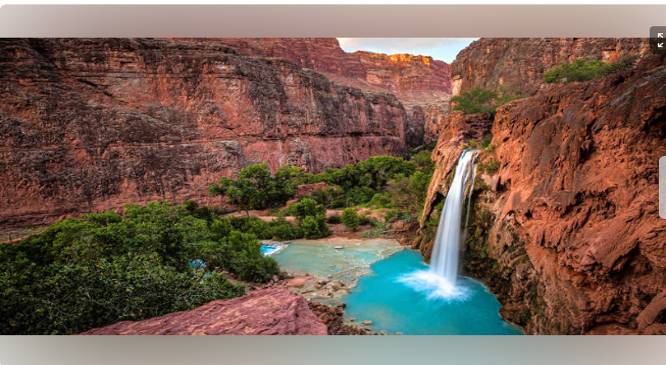- The Denmark Strait Cataract is the largest waterfall in the world, located beneath the Denmark Strait between Greenland and Iceland. It is 100 miles wide.
- The cataract is an underwater waterfall, dropping 11,500 feet straight down from the Greenland Sea into the Irminger Sea, releasing 175 million cubic feet of water per second.
- Tourists cannot visit the Denmark Strait Cataract as it is completely submerged, making scuba diving the only way to see it. The water from the cataract generates a large current that flows south.
Read More:-China Turns Tables on US Over Dangerous Military Moves
Waterfalls are among the world’s most exquisite natural tourism destinations. Millions of individuals adore witnessing nature’s most calming but thrilling creation, and they place certain cities or countries on their bucket lists. Exploring a waterfall is the most thrilling thing they can ever do. Certain waterfalls are simply breathtaking to see and hike to, but there’s one that tops them all — the largest waterfall in the world.
The greatest waterfall in the world is located beneath the Denmark Strait, which divides Greenland and Iceland. A sequence of cataracts may be found at the bottom of the strait. They start 2,000 feet (609.6 meters) below the surface of the strait and plummet over two miles (3.2 kilometers) to a depth of 10,000 feet (3048 meters) at the southern tip of Greenland. Here is what to know about the world’s largest waterfall, the Denmark Strait Cataract.
Read More : Here’s what ‘wealthy’ means in 2023 America, in five numbers
The Denmark Strait Cataract Is The Largest Waterfall In The World
The massive waterfall, the Denmark Strait Cataract, is situated in the narrow stretch of ocean that separates Greenland and Iceland. It is 100 miles (160 kilometers) wide.
It dwarfs any enormous waterfall tourists might find on land as it drops 11,500 feet (3,505.2 meters) straight down from the blue Greenland Sea into the Irminger Sea, transporting almost 175 million cubic feet (approximately 5 million cubic meters) of water each second.
Read More : The best iPhone 15 deals: Where to get the best trade-in prices
The fact that an underwater waterfall can exist at all is arguably more amazing than how the Denmark Strait Cataract grew to be so large and powerful.
Although it is simple to imagine the ocean as a huge bathtub that fluctuates with the tides, seawater is highly dynamic; on both large and small sizes, waters with varying salinities and temperatures, and therefore densities, are constantly interacting.
The temperature differential between the extremely cold Greenland Sea waters and the marginally milder Irminger Sea waters creates the Denmark Strait Cataract, the world’s largest underwater waterfall.
- Width of the largest waterfall in the world: 100 miles (160 kilometers)
- Location: Denmark Strait between Greenland and Iceland
Read More:-A wingsuit flyer was decapitated when he jumped out of a plane and got struck by its wing
How Did The Denmark Strait Cataract Form?
The Irminger Sea and the Greenland Sea’s disparate temperatures are eventually what gives rise to the marvel known as the Denmark Strait Cataract. The Irminger Sea is somewhat milder than the Greenland Sea, which features frigid Arctic waters.
When the two seas converge, the Greenland Sea falls into the waterfall formation because the cold water becomes denser. The largest waterfall in the world releases 175,000,000 cubic feet (approximately 5 million cubic meters) of water each second as it plummets nearly two miles (3.2 kilometers). It offers one of the main sources of deep water in the North Atlantic.
- Main factor in the formation of The Denmark Strait Cataract: Temperature differences
Also Read:- The U.S. Is Trapped in Syria’s Complex Mosaic | Opinion
Can You See The World’s Largest Waterfall?
Unfortunately, tourists are unable to visit the largest waterfall on Earth. In other words, tourists cannot visit the Denmark Strait Cataract in the same manner as you would visit, say, Niagara Falls. There will not be an overlook or moments of wowing over the spray of cataracts.
Actually, there are not any rainbows at all, and the reason for this is that the Denmark Strait Cataract is completely submerged. The world’s largest waterfall in the water is inaccessible, and getting too near would be a dangerous adventure.
Read More : 5 Tech Stocks that are hitting a year high.
Tourists have nowhere to go to admire and absorb the mist created by the waves of the ocean. Additionally, there is no souvenir store nearby to pick up trinkets and mementos, and there is no daring tour guide offering to take them there to try and view the wonderful cascades of Denmark’s waterfall.
Since it is underwater, scuba diving is the only way to see the Denmark Strait Cataract!
Interesting Facts About Denmark Strait Cataract
Once the water from the Denmark Strait Cataract reaches the ocean floor, it does not simply sit there; instead, it generates a large current that flows south, replacing the warmer surface water that was flowing north. This enormous flow of water is equivalent to 20–40 times the total volume of river water entering the Atlantic.
Northern surface waters are warmer. These warmer waters drop as they progressively lose heat to the environment. Over an underwater ridge in the Strait, a deep current of denser, colder water moves southward down the sea floor.
Read More : 7 Easy Tips to Refresh Your Home in 2023
The cataract in the Denmark Strait is around 11,500 feet (3,505.2 meters) high. In contrast, 3,212 feet (979 meters) is the biggest waterfall on land.
- Height of the largest waterfall in the world: 11,500 feet (3,505.2 meters) high















































